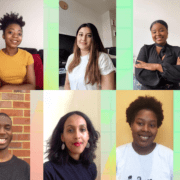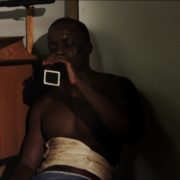How animation and gaming has coded a new culture for the way we create and consume music

The marriage between music and animated visuals is a long and happy one – especially for millennial and Gen Z musicians who use animation inspired by gaming and comics in their work. I spoke with creatives across different disciplines about the ways that animation and gaming culture has inspired their approach to their work.
Gaming is a big part of how we explore our creative agency in private ways – often a way into being creative without realising. In some cases, gaming and music can foster both safe and instructive places for those who are often the targets of attempted erasure. An interdisciplinary artist who does this in a ground-breaking way is Danielle Brathwaite-Shirley. Danielle is the creator behind Black Trans Archive, an interactive digital archive video game which uses technology to create a space where Black trans people are centred and have their stories told. Such projects hopefully point towards a culture of gaming and animation soundscapes that are ethically led from the heart of the coding process.
I spoke with DJ, producer and Digi-Artist Elise Rose about digital selves in music and she told me:
“I’ve always been fascinated with RPGs, computer game characters and the idea of recreating yourself digitally into whatever you fantasise, without the restrictions that we have in reality. So when I started DJing and making music, I was drawn to the idea of a digital avatar that can push the narrative of the music into a multi sensory experience. I think avatars and animated alter egos could be the future for introverted artists and people of colour who don’t often have the same access to materials, garments and opportunities. We can use this technology to push the boundaries of gaming and performance, and interact with our audience in ways that we could only imagine in real life, on such a global scale.”

Games like Fortnite are expanding the scales of which we distribute and tailor our music, both through becoming a new digital stage and in the way that the repetition of an in-game song will permeate into your daily life. More than 12 million concurrent players tuned in to watch Travis Scott as a digi-giant in a ten-minute performance called Astronomical where he also debuted ‘THE SCOTTS’ in collaboration with Kid Cudi. My 11-year old nephew Kaya watched that in awe and will probably recount that as one of his most distinctive memories of lockdown. In the bond between celebrity and avatar we see musical icons boosted into a state that is beyond human to their fans.
Rappers like Domo Gorille are part of a generation of Dragon Ball Z / Cartoon Network watchers who posit themselves into avatars through their work. In his latest alt-drill track ‘SHELLINA GOMEZ‘, Domo uses Selina Gomez‘ Disney channel show ‘Wizards of Waverly Place’ as a metaphor for his own alchemic approach to music. He created an accompanying animation of himself as a warlock holding a tome of musical gems. In an interview with him earlier in the year about his visuals for his video ‘Pain into Millions‘, he reiterated how much watching anime in his childhood inspired his art:
“We grew up watching anime and Dragon Ball Z, after primary you’d go straight in and watch that on Toonami or Cartoon Network. And then go trace the characters through the light of the windows! The age of technology was TV.”
The way that these different components intertwine and work as a hybrid has paved the way for Domo’s distinctly neo-psychedelic rap style.
Curious about how producers use the sonic landscape of the games they grew up playing, I spoke with Rayman Beats who produced ‘SHELLINA GOMEZ’ who’s moniker stems from the iconic video game character. On his influences musically, Ray told me:
“Growing up I fell in love with Game Boy, fell in love with Super Mario, Tetris…Animaniacs, N64, Golden Eye – I mention these games because these OSTs did something to me. I felt OSTs (especially in anime) had my brain going crazy, rah what are these sounds? It’s always about the sounds for me, the foley, that all makes the tracks. I now try to make my own music have that sort of feel to it, atmospheric, mood-driven… My favourite game OST is L.A. Noire, it had a jazz feel – a lot of producers who I look up to such as Cardo, Yung Exclusive, Metro… they all delve within that realm of sampling outlandish sources and making it sound wavey, I feel like that’s where I get my inspiration from too.”
Music can construct a platform for visual art to be viewed through. Many recent releases speak to this. The apocalyptic game style visuals created by Theo Blackledge for Jaykae’s song ‘Novacaine’ do this interestingly. He emphasises the vulnerabilities of the MC through the glitching stuttering nature of his avatar while simultaneuously making him the 9-lived hero of a Resident Evil-like game.
Conceptual music artist Iman Lake recently released a project on our dystopian present called ‘Stranger Days’. A three-pronged release of comic-book, animated video and song. Azeez Bello, the director for the video and long-term collaborator spoke with me about the importance of childhood and subconscious learning on the art we make:
“If one of the main things we consumed as children were cartoons and anime, of course our art becomes directly related to this. Full of subliminal messages too!”
He also drew attention to Mira May‘s artwork for her song ‘Woman Like Me’, a recreation of anime characters Naruto and Sasuke‘s relationship. But instead substituted herself and her boyfriend Harry Pinero wearing the anime duo’s iconic outfits. There is something about fan culture and living out the legacy of what we grew up consuming in our day-to-day lives that has created a musical generation striving to add themselves to the lineages they love.
I’m excited though, for where this is heading and what this means for younger generations. We live in an Instagram age of visuals, where ‘Class of 3000’ by Andre 3000 has been aired on Cartoon Network and children wear custom skins of their favourite musicians in the games they play. The scope for where musical artists can go is broader than ever, as digital stages mean artists can work from home to concoct the most ambitious concepts.




![ZINO VINCI’S ‘FILTHY & DISGUSTING’EP BRINGS YOU TO THE CORE OF THE ARTIST [@ZinoVinci]](https://guap.co/wp-content/uploads/2023/10/Zino-4.jpg)




